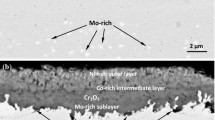Abstract
The effect of thermal shock on the spalling of oxides from the surfaces of several commercial alloys was determined. The average cooling rate was varied from approximately 240°C/sec to less than 1.0°C/sec during cyclic oxidation tests in air. The tests consisted of 100 cycles of 1 hr at the maximimum temperature (1100 or 1200°C). The alloys were HOS-875, TD-Ni, TD-NiCrAl, In-601, In-702, and B-1900 plus Hf. All of these alloys exhibited partial spalling within the oxide rather than total oxide loss down to bare metal. Thermal shock resulted in deformation of the metal, which in turn resulted, in most cases, in change of the oxide failure mode from compressive to tensile. Tensile failures were characterized by cracking of the oxide and little loss, while compressive failures were characterized by explosive loss of platelets of oxide. This behavior was confirmed by examination of mechanically stressed oxide scales. The thermally shocked oxides spalled less than the slow-cooled samples with the exception of TD-NiCrAl. This material failed in a brittle manner rather than by plastic deformation. The HOS-875 and the TD-Ni did not spall during either type of cooling. Thus, the effect of thermal shock on spalling is determined, in large part, by the mechanical properties of the metal.
Similar content being viewed by others
References
P. Kofstad,High-Temperature Oxidation of Metals (Wiley, New York, 1966).
K. Hauffe,Oxidation of Metals (Plenum, New York, 1965).
C. A. Barrett and C. E. Lowell,Oxid. Met. 9, 307 (1975).
C. E. Lowell and W. A. Sanders,Oxid. Met. 5, 221 (1972).
P. Hancock and R. C. Hurst, inAdvances in Corrosion Science and Technology, Vol. 4, R. W. Staehle and M. G. Fontana, eds. (Plenum, New York, 1974).
D. L. Douglass,Oxidation of Metals and Alloys (American Society for Metals, Metals Park, Ohio, 1971), p. 137.
J. L. Smialek, “Oxide Morphology and Spalling Model for NiAl,”Metall. Trans. A,9A, 309 (1978).
C. S. Giggins and F. S. Pettit, “Oxide Scale Adherence Mechanism,” ARL TR 75-0234 (June 1975).
F. A. Golightly, F. H. Stott, and G. C. Wood,Oxid. Met. 10, 163 (1976).
C. A. Barrett and C. E. Lowell,Oxid. Met. 11, 199 (1977).
D. L. Deadmore and C. E. Lowell,Oxid. Met. 11, 91 (1977).




